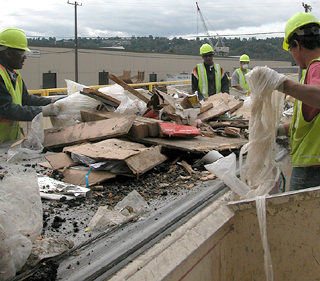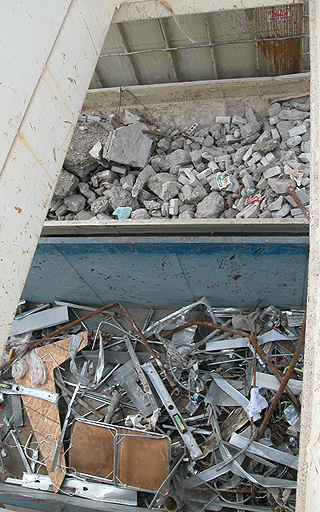|
Subscribe / Renew |
|
|
Contact Us |
|
| ► Subscribe to our Free Weekly Newsletter | |
| home | Welcome, sign in or click here to subscribe. | login |
Construction
| |

September 20, 2007
Where does that construction waste go?
Journal Staff Reporter
BUILDING OWNERS, developers and contractors are told that recycling construction and demolition waste is good for the environment. But what happens to the waste after it leaves the site?
In Seattle and King County, construction and demolition debris make up about 30 percent of the yearly waste stream at 400,000 tons. In 2006, the state Department of Ecology estimated about two-thirds of that is sent to landfills while the remaining third gets recycled.
Chris Martin, president of private waste hauling company CleanScapes, said about 75 percent of waste sent to landfills is reusable or recyclable. “If all that stuff was shipped to a third would country, they'd be building houses out of it,” he said.
About a year ago, Martin decided Seattle contractors needed a plant that only processed waste from construction and demolition. A similar plant, Recovery 1, operates out of Tacoma. Other local options are transfer stations or plants that also recycle other materials.
Martin said he read both county and city comprehensive plans and came away thinking the private sector should build these plants. So he set up CDL Recycle, a business that began with workers manually sorting through waste in CleanScapes' backyard. Now, the company is operating out of a Georgetown plant that's a little more high tech.
It begins when waste haulers or private companies dump waste at CDL's plant. Waste is transferred to an above-ground conveyor belt with chutes on each side that end in large holding containers for different materials. Workers are assigned a specific waste to pull from the belt, which they throw down the chutes. Waste left on the conveyor belt after separation is shipped to a landfill.
Materials pulled from the conveyor belt are cardboard, plastic films, hard plastic, ferrous and nonferrous metal, concrete, aggregates and gypsum.
After the material has been separated, it goes to different processors. Cardboard is recycled back into cardboard; plastic is recycled into plastic products such as fleece coats, pop bottles and piping; metal is reused for items such as I-beams or car machinery; gypsum becomes drywall; and wood is either recycled into wood products or burned for fuel.
CDL gets paid for some of the materials, such as cardboard and metal. For materials such as wood and drywall, it pays the processor. “We don't ship anything (that gets reused) out of King County,” Martin said. “Instead of going to a landfill, these materials are staying in the local economy.”
According to King County, CDL has a 98 percent recycling and diversion rate with 52 percent of that recycled into new products and 20 percent burned for fuel. Recovery 1 also has a 98 percent recycling and diversion rate, though 52 percent is burned for fuel and 29 percent is recycled. Other plants have recovery rates below 73 percent.
CDL mostly processes waste from new construction projects. Clients include Microsoft, Vulcan and Urban Visions.
For projects shooting for LEED, sending construction and demolition waste to a sorting plant can help get points.
Alex Bennett, asset manager with Kennedy Wilson, said to help with LEED points for the remodel of the 41-story office building at 901 Fifth Ave., all construction and demolition waste gets sent to CDL. Six months ago, Kennedy Wilson used Rabanco but it switched because of CDL's high diversion rate. “(Rabanco) wasn't sorting and recycling, they were just disposing,” Bennett said.
Both companies that hold the city's waste hauling contract, Waste Management and Rabanco through its parent company Allied Waste Systems, own landfills.
Because CleanScapes owns no landfill, it is cheaper to process construction and demolition waste than to dump it at the city waste transfer station at $110 a ton, Martin said. For hauling companies that own landfills, Martin said it costs about $30 to send a ton of waste to a landfill.
Demolition crews that don't send waste to a sorting plant often put waste into on-site boxcars that are loaded onto a mile-long waste train going to a landfill in Arlington, Ore. That costs about $60 a ton. CDL charges $85 a ton.
It is more expensive but Bennett said it's a minor cost. “The cost premium is trivial and almost unrecognizable in the scheme of the budgets.”
The mile-long train leaves six times a week. Martin said if 75 percent of Seattle and King County's total construction and demolition waste were removed from that train it would only make five weekly trips.
Katie Zemtseff can be
reached by email or by phone
at (206) 622-8272.
Previous columns:
- Engineers work to keep a floating bridge floating, 09-06-2007
- A high-tech solution for crane safety?, 08-30-2007
- School district tries to beat inflation by building three schools at once, 08-16-2007
- Construction pricing guide goes green, 08-09-2007
- Want to start your own apprentice program?, 08-02-2007
- Habitat for Humanity sees green in Olympia, 07-19-2007
- City program gives kids a taste of utility work, 07-12-2007
- A $200M future for Everett Community College, 07-05-2007




